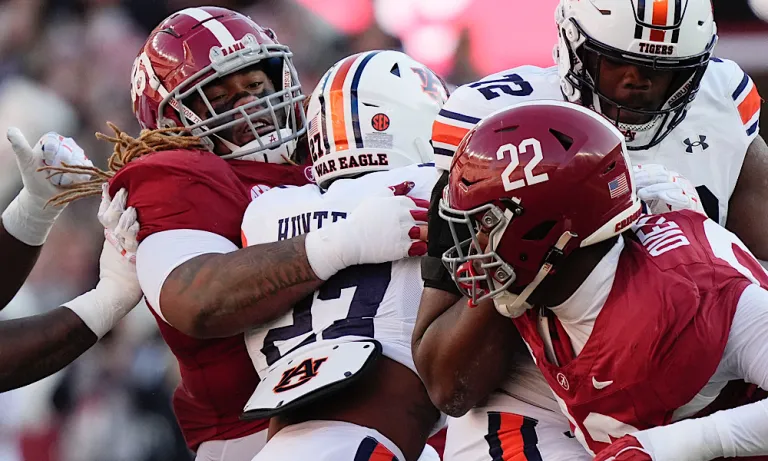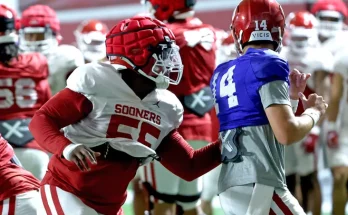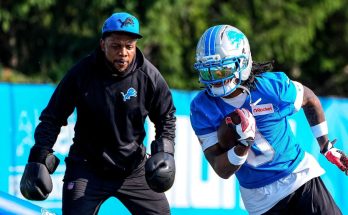Alabama football has long been synonymous with defensive excellence, particularly up front in the trenches. Year after year, the Crimson Tide reload, not rebuild, their defensive line—a unit often referred to as the heart of the Alabama defense. As the 2025 season approaches, players and coaches within the program are echoing a familiar but bold sentiment: this year’s defensive line might be one of the best in the country.
The confidence radiating from Tuscaloosa isn’t built on hype alone. It’s grounded in the physicality, depth, experience, and sheer talent that the defensive line room possesses. From seasoned veterans to young stars with NFL futures, the Tide have stacked the deck, and the players believe that their collective power can dominate the trenches in a way few other programs can match.
To understand where this confidence comes from, it helps to look at the makeup of the group. The return of multiple experienced starters is the foundation. Seniors like Tim Keenan III and Jah-Marien Latham provide leadership and production, having played in big-time SEC games and knowing what it takes to win in hostile environments. Keenan, a 6-foot-2, 315-pound nose guard, is a disruptive presence in the middle. His ability to eat up double teams and still push the pocket is critical to everything Alabama wants to do defensively. He’s vocal in his belief that this year’s line is different—not just in potential, but in approach. “We play for each other,” Keenan said in spring camp. “It’s not just about stats or spotlight. We’re all dogs, and we want to be the engine of this defense.”
Latham echoes a similar tone. After flashing serious upside last year, he’s come into 2025 with a renewed focus on consistency and violence at the point of attack. “We’re not trying to be average. We’re trying to be legendary,” he said. “Coach [Kane] Wommack has been pushing us hard, and it’s made us closer. We believe we’re going to be the most feared group in the country.”
Coaching, of course, plays a vital role. The Tide’s defensive line is under the guidance of new defensive coordinator Kane Wommack and returning line coach Freddie Roach. Wommack brings an aggressive mindset with an emphasis on dictating tempo and confusing offenses. His scheme allows the defensive front to be more active and versatile. Alabama isn’t just asking its linemen to eat space—they want them attacking, penetrating, creating havoc.
Roach, meanwhile, continues to earn respect as one of the most effective position coaches in college football. His ability to develop raw talent into refined pass rushers and run-stoppers is a key reason why Alabama always seems to have elite defensive line play. Under his watch, players like Quinnen Williams, Christian Barmore, and Phidarian Mathis have turned into NFL stars. Current players are quick to praise Roach’s attention to detail and his demand for excellence in every rep.
While the veterans provide stability, it’s the influx of young talent that has Alabama’s locker room buzzing. Sophomore James Smith and redshirt freshman Jordan Renaud are just two names that have turned heads throughout spring and summer workouts. Smith, a former five-star recruit out of Montgomery, Alabama, possesses freakish athleticism for a player his size. At 6-foot-4 and 305 pounds, he moves with the agility of a linebacker and hits like a freight train. His ability to collapse the pocket and disrupt zone-read plays makes him an every-down threat.
Renaud, on the other hand, has the frame and attitude of a future All-SEC force. His motor runs hot, and coaches have raved about his growth both mentally and physically since arriving on campus. One assistant said Renaud reminds them of a “young Jonathan Allen”—high praise for any Alabama lineman. With Smith and Renaud pushing the veterans and earning reps in key packages, the line has the kind of depth championship teams require.
Another name that’s drawing buzz is freshman Dominick McKinley. The Louisiana native, another five-star recruit, had offers from nearly every major power program but chose Alabama because, as he put it, “This is where you go to become great.” Early returns suggest he may be right. McKinley’s strength and bend off the edge have already led to some dominant practice reps, and he’s positioning himself as a possible rotational player in Week 1.
Depth isn’t just a luxury—it’s a necessity in the SEC. With offensive lines growing bigger, faster, and more sophisticated, Alabama’s ability to rotate six or seven linemen without a drop-off is critical. The players understand this too. There’s a real sense of competition in the room, but it’s healthy, and it’s forged by mutual respect and a shared goal. “We don’t care who makes the play,” said Keenan. “If one of us eats, we all eat.”
Beyond individual talent, the defensive line’s chemistry is often overlooked. These aren’t just players sharing a locker room—they’re a brotherhood. That bond was strengthened during offseason workouts, film sessions, and long hours in the weight room. Their unity shows on the field, where communication and gap integrity are crucial. One breakdown can lead to a big play; one great stunt or twist can lead to a game-changing sack. The trust between these linemen allows them to play fast and aggressive, knowing the man next to them will do his job.
That confidence was on full display in Alabama’s spring game. The defensive line dominated the line of scrimmage, tallying multiple sacks, pressures, and tackles for loss. While spring performances don’t always translate directly to the fall, the dominance was hard to ignore. Even head coach Kalen DeBoer, typically reserved in his praise, admitted, “Our defensive line set the tone today. They played with violence and purpose.”
The confidence isn’t just internal, either. NFL scouts have been circling Tuscaloosa all offseason, drawn by the talent-rich front. Several linemen have already been placed on early watchlists for national awards like the Outland Trophy and Nagurski Award. It wouldn’t be surprising if two or even three players from this group hear their names called early in the 2026 NFL Draft.
It’s easy to talk about potential in June, but the players know that reputation alone won’t win games. The SEC is unforgiving, and Alabama’s 2025 schedule features a brutal gauntlet of elite offenses, from Georgia to LSU to Oklahoma. But the Tide’s defensive linemen are embracing the challenge. “We want to face the best,” said Latham. “That’s why we came here. That’s why you sign with Alabama. If you want to be great, you’ve got to play like it against the best teams in the country.”
Perhaps the most telling part of Alabama’s belief in their defensive line comes from those who see them every day—namely, their own offensive teammates. Offensive linemen and quarterbacks alike have admitted privately and publicly that this group is relentless, fast, and smart. “They don’t give you anything easy,” one offensive lineman said. “They’re strong, yeah, but it’s the way they move and communicate that messes with you. Every snap is a battle.”
When the Crimson Tide take the field this fall, much of the national attention may focus on quarterback play or the wide receiver room. But don’t be surprised if it’s the big men up front on defense who steal the spotlight. They’ve been working in silence, stacking good days, sharpening each other, and feeding off the legacy of those who came before them.
The defensive line has always been a pillar of Alabama’s success, but this group believes they’re building something even greater—a unit that can redefine dominance, intimidate opposing offenses, and lead the Crimson Tide to a national championship. And if the players are right, the rest of the country is about to find out what it means when Alabama’s defensive line plays with a chip on its shoulder and a point to prove.



